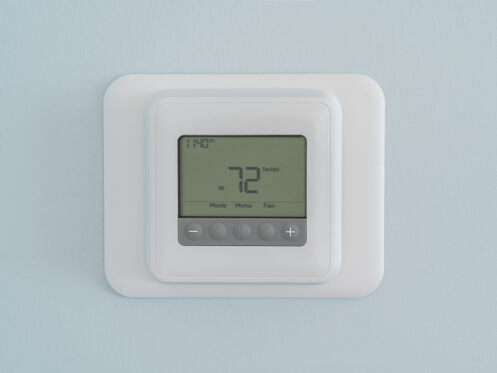HVAC is the number one contributor to the carbon footprint of the average American home. The industry has made impressive strides in reducing that impact. More energy-efficient heating and cooling solutions have been one way they’ve done that. Another is smart thermostats. Let’s explore some of the energy-saving features that are already available.
Automated Adjustment
Scheduling is a core feature of any programmable or smart thermostat. It lets the user set a heating and cooling schedule that the thermostat will automatically follow. Doing so can save considerable energy while sleeping and not at home. The Department of Energy (DOE) estimates that most homes can reduce energy usage by 5% to 15% this way.
Advanced Smart Setback
Setback refers to a thermostat adjusting the temperature for energy savings and to return to normal. It’s an inefficient aspect of scheduling because an HVAC system uses more energy to reach a temperature than to sustain it. Thermostats with advanced smart setback monitor this process and make adjustments to minimize losses during these periods.
Learning
Smart thermostats can monitor your household’s HVAC usage and make recommendations or adjustments automatically. The advanced setback feature is one example of learning. These thermostats can also optimize schedules to cut down on energy usage. Such capabilities are getting even more powerful through the use of cloud computing. The computational power a smart thermostat has onboard no longer limits its learning.
The industry expects artificial intelligence (AI) to be a powerful smart thermostat tool moving forward. Despite the widespread adoption of smart thermostats, the U.S. Energy Information Administration (EIA) estimates only 12% of households set or update their schedules. AI is removing those barriers and will make active scheduling a more ubiquitous part of home HVAC.
Vacation Mode
A vacation or away mode can significantly reduce energy consumption while you’re away from the home for an extended period. Some units use a set temperature whereas others can adjust automatically based on ambient factors. Other common modes include hold, which lets you override programming, and eco, which emphasizes energy consumption. Many systems also support profiles, and each profile contains a distinct schedule. You can have profiles for days of the week, months of the year, seasons, and even people.
Geofencing
Dynamic schedules are superior because many households don’t have fixed schedules. Learning is one approach through which smart thermostats can operate more dynamically. Geofencing is another. This feature uses GPS or RFID to create a virtual boundary around your home. The system then knows when household members are inside the boundary and when they’re not. That allows the system to ignore set programming and adjust home comfort based on the current circumstances.
Occupancy Sensors
Advanced systems can take this concept a step further through occupancy sensors. It’s a powerful feature in areas of a home that go unused for long periods. With sensors, the system will know when the area has been unoccupied for an extended period and can adjust accordingly.
Remote Control and Access
Wi-Fi is the core feature that makes a programmable thermostat a smart thermostat. With Wi-Fi, your thermostat can connect to your home network. That lets it communicate with other devices. It also allows it to connect to the internet. You can access and control the thermostat from your phone while sitting on the couch. You can also do that from the road when you just realized you forgot to put the system into vacation mode.
Zone Control
The traditional HVAC system has a single zone: the entire home. Zoned systems organize a home into separate areas that you can adjust independently. The DOE estimates that such systems can reduce energy consumption by 15% to 30%. Doing so requires a thermostat that can adjust features like multi-speed blowers, active dampers, and smart vents.
Remote Sensors
These systems often support an array of remote sensors. Multiple sensors reduce the importance of thermostat positioning and let you locate a thermostat for convenience within a zone. A sensor array also provides you with a more accurate assessment of a home. You can have sensors outside the house as well as in. You can also have sensors for other data than just temperature. That includes relative humidity (RH), carbon monoxide (CO), smoke, and other aspects of indoor air quality.
Relative Humidity
RH is important to home comfort, and many smart thermostats provide both RH and temperature controls. This includes “feels like” temperature settings. This feature lets you set the thermostat based on how you want to feel rather than a strict temperature. It can often reduce energy usage in winter and summer by several percentage points.
Demand Response
Many local utility companies have opt-in programs that allow them to adjust their customers’ smart thermostats during peak demand. To opt in, you need a thermostat with these compatible demand response features.
Energy-Saving Modes
Often, smart thermostats have an energy-saving mode that balances energy use and comfort. In other words, the mode will get you as close to your ideal comfort as possible without consuming excessively. What’s excessive? That’s based on the parameters you set. Some thermostats can also adjust those parameters dynamically based on energy rates.
Weather Monitoring
Earlier we mentioned that transitional periods for a thermostat result in increased energy consumption. These transitions happen because of weather changes as well. Smart thermostats with weather monitoring can access real-time weather data and adjust accordingly. A thermostat can, for instance, turn up the heat gradually in advance of a cold front. This can make a big difference in energy usage in areas that often experience sharp temperature changes.
Energy Monitoring
Spikes in energy usage are often the first indication an HVAC system has a malfunction. Smart thermostats can identify such spikes and alert you early on. These thermostats can also track your usage by day, month, and year. Many systems can also analyze the data and provide reports that help you reduce your usage further.
Smart Device Integration
Smart thermostats are smart devices that can integrate into your home automation system and the Internet of Things in general. Consider a smart thermostat that can put your smart water heater into vacation mode alongside itself. Your thermostat can also communicate with smart ceiling fans, shades, refrigerators, and much more.
Performance Monitoring and Alerts
Many smart thermostats can receive performance data from the HVAC system and alert you based on that information. An example is the system noticing a change in the RPM of the blower and the thermostat alerting you to schedule a diagnostic appointment.
Would You Like to Reduce Your Carbon Footprint?
Cozy Home Services is a BPI-certified HVAC company that helps homeowners through Vacaville and the surrounding areas lower their environmental impact. Our experts perform home performance analyses and design and install solar panel arrays. We have HVAC technicians skilled in heat pumps, ductless mini-splits, furnaces, air conditioners, and smart thermostats. Our indoor air quality team provides ductwork, ventilation, and air purification services. Our electricians install and repair electrical panels. We have plumbers who pipe and repipe water, sewer, and gas lines. We also install and service kitchen plumbing, bathroom plumbing, water heaters, water filters, water softeners, and leak detection systems. Call today or contact us online to schedule an appointment.


